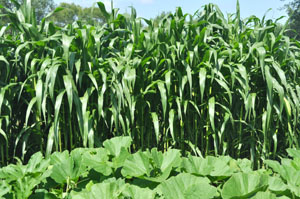Posted by · Leave a Comment
Cucumber beetles…. mere mention strikes fear in the hearts of vegetable gardeners, countrywide. Or, at least, it should.
 They attack flowers and ornamentals as well as cucumbers. In fact, over 270 plants in 29 families fall prey to this little trouble-maker.
They attack flowers and ornamentals as well as cucumbers. In fact, over 270 plants in 29 families fall prey to this little trouble-maker.
To learn more, I consulted Golden Harvest Organics online library. It was fascinating to learn (among other things) that the beetles actually transmit bacterial diseases which overwinter in their intestines, infecting plants in their earliest of stages.
According to ghorganics.com, the striped cucumber beetles do the most damage to the cucumber families or cucurbits, appearing a good four weeks before their spotted relatives.
Aside from hitting potatoes, squash, asparagus, tomatoes, fruits, and melons, they go after corn with a vengeance. Larvae infestation will impact the root system so forcefully, the corn appears to be drought-stricken. Adult beetles burrow into the silks when pollination is due to occur—resulting in “poor grain set.”
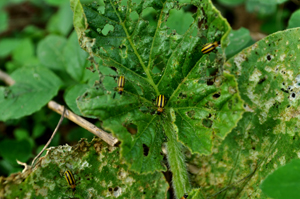 There are repellent plants which could be planted to deter the beetle and various other organic methods. (Try placing aluminum foil beneath plants to reflect light—the beetles prefer the underside of leaves because of the shade.)
There are repellent plants which could be planted to deter the beetle and various other organic methods. (Try placing aluminum foil beneath plants to reflect light—the beetles prefer the underside of leaves because of the shade.)
David prefers the route of “integrated pest management” (IPM). Which is our very next blog entry….
Stay tuned.

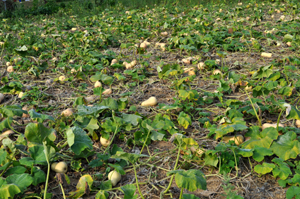 We grow rows and rows of butternut squash to allow proper garden space (after growing butternut for more than 10 years, I am still amazed at the amount of space the squash will eventually require).
We grow rows and rows of butternut squash to allow proper garden space (after growing butternut for more than 10 years, I am still amazed at the amount of space the squash will eventually require). The beans are nestled close to the corn, and once trained, will likely be very happy to hitch a ride on the cornstalks. This saves us the trouble of arranging a trellis of some sort and is a connection to history we’re happy to make.
The beans are nestled close to the corn, and once trained, will likely be very happy to hitch a ride on the cornstalks. This saves us the trouble of arranging a trellis of some sort and is a connection to history we’re happy to make.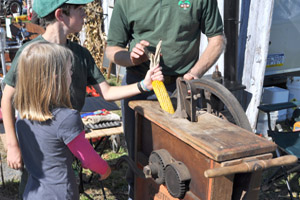 As we strolled past a corn sheller, the gentleman operating it pointed to Nathaniel and said, “Young man, your mom wants to make corn bread!!” Nathaniel looked up, quizzingly, as the man repeated, “she needs your help—go on out and gather a bushel of corn.”
As we strolled past a corn sheller, the gentleman operating it pointed to Nathaniel and said, “Young man, your mom wants to make corn bread!!” Nathaniel looked up, quizzingly, as the man repeated, “she needs your help—go on out and gather a bushel of corn.”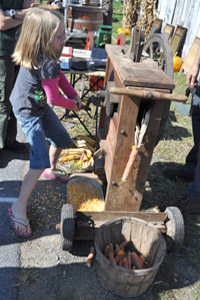
 You can imagine they were both smiling by now as Natalie cranked the wheel and Nathaniel added the corn. Once the mill chewed the kernels off, they began spilling out the chute.
You can imagine they were both smiling by now as Natalie cranked the wheel and Nathaniel added the corn. Once the mill chewed the kernels off, they began spilling out the chute. So they gathered the kernels and put them down the mill chute and began to crank. The bowl caught the light, yellow, cracked and milled corn.
So they gathered the kernels and put them down the mill chute and began to crank. The bowl caught the light, yellow, cracked and milled corn.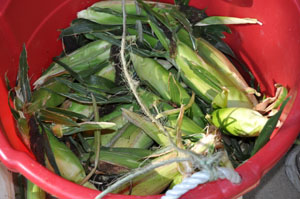 We bade a fond farewell to our sweet corn a week ago.
We bade a fond farewell to our sweet corn a week ago.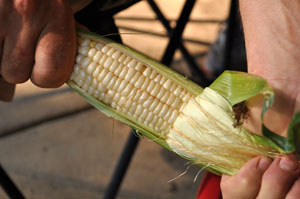 My husband always plants the old standby “Silver Queen.” It’s been a popular variety with farmers for decades and has a maturity of 92 days. This year, we also planted “Bodacious” which has a 75-day maturity and “Delectable” with an 84-day maturity. The different days to maturity as well as staggered plantings, allow for a sweet corn harvest over several summer weeks if you’re a savvy planter!
My husband always plants the old standby “Silver Queen.” It’s been a popular variety with farmers for decades and has a maturity of 92 days. This year, we also planted “Bodacious” which has a 75-day maturity and “Delectable” with an 84-day maturity. The different days to maturity as well as staggered plantings, allow for a sweet corn harvest over several summer weeks if you’re a savvy planter! right off the cob!
right off the cob!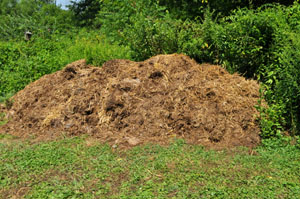 This very brown pile is responsible for making our corn very happy.
This very brown pile is responsible for making our corn very happy. 